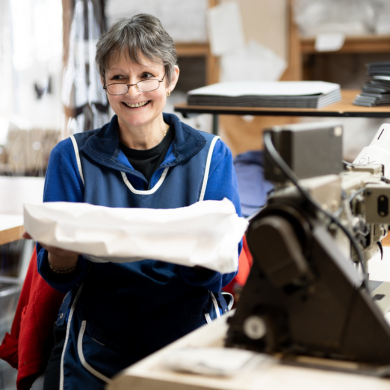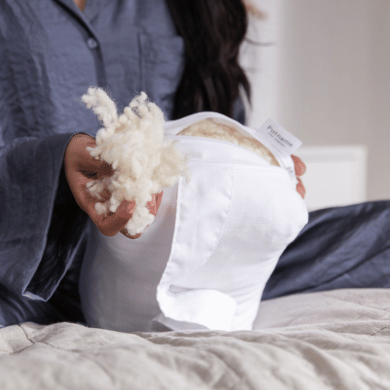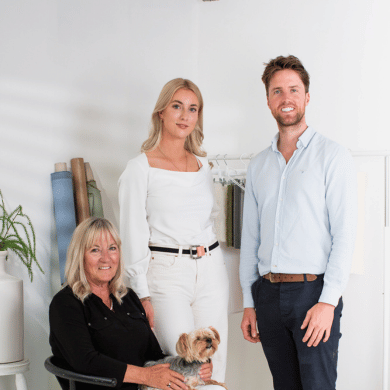
Die Zukunft des Schlafs: Wie werden Schlafzimmer im Jahr 2050 aussehen?
Das Jahr 2050 weckt oft Assoziationen mit fliegenden Autos und Roboterassistenten. Doch was wird aus dem intimsten Raum unseres Zuhauses, dem Schlafzimmer? Blicken wir auf die Zukunft des Schlafs, so liegt die Vorstellung einer Welt, die von hochintelligenten Geräten und komplexen Datenströmen beherrscht wird, nahe. Die wahre Innovation für einen gesunden Schlaf liegt jedoch womöglich nicht in der Menge an Technologie, die wir einsetzen, sondern darin, wie wir sie mit zeitlosen Prinzipien von Komfort und Nachhaltigkeit verbinden.
Wie wird der Schlaf im Jahr 2050 aussehen? Wahrscheinlich wird es ein durchdachtes Gleichgewicht zwischen intelligenter Technologie und natürlicher, erholsamer Ruhe sein.
Diese Untersuchung beleuchtet die spannenden Trends der Schlaftechnologie, die sich abzeichnen – von KI-gestützten Matratzen bis hin zu biometrischer Bettwäsche. Wir gehen auch der wachsenden Bedeutung nachhaltiger Betten nach und ergründen, warum klassischer Komfort weiterhin unverzichtbar bleibt. Letztendlich werden wir feststellen, dass es beim idealen Schlafzimmerdesign der Zukunft nicht darum geht, die Natur durch Technologie zu ersetzen, sondern Innovationen zu nutzen, um unser Bedürfnis nach echtem Komfort zu stärken.
Die Technologie, die den Schlaf revolutioniert
Die nächsten 25 Jahre versprechen eine Welle von Innovationen im Bereich der Schlafgesundheit, mit Technologien, die entwickelt wurden, um unseren nächtlichen Schlaf zu überwachen, anzupassen und zu verbessern.
Diese Weiterentwicklungen zielen darauf ab, eine personalisierte Schlafumgebung zu schaffen, die in Echtzeit auf unseren Körper reagiert.
KI-gesteuerte Matratzen und intelligente Betten
Stellen Sie sich eine Matratze vor, die nicht nur Ihre Schlafzyklen aufzeichnet, sondern sich aktiv anpasst, um sie zu verbessern. KI-gesteuerte Matratzen nutzen Sensoren, um Ihre Herzfrequenz, Atmung und Bewegungen zu überwachen. Wenn sie feststellt, dass Ihnen zu warm ist, kühlt sie möglicherweise ihre Oberfläche. Wenn Sie schnarchen, hebt sie Ihren Kopf sanft an, um Ihre Atemwege zu öffnen. Licht-, Geräusch-, Pollen- und Virenfilter werden Standard sein.
Das ist das Versprechen intelligenter Schlaftechnologie: ein Bett, das mit Ihnen zusammenarbeitet.
Biometrische Bettwäsche könnte noch einen Schritt weiter gehen. Mit Mikrosensoren durchzogene Stoffe könnten Ihre Vitalfunktionen erfassen und sogar Ihren Stresspegel über die Hautleitfähigkeit analysieren. Diese Daten könnten dann mit dem Ökosystem Ihres Zuhauses synchronisiert werden, um die Beleuchtung zu dimmen und die Heizung anzupassen und so optimale Bedingungen für einen erholsamen Schlaf zu schaffen.
Siehe auch – Wie intelligente Schlaftechnologie die Zukunft erholsamer Wohnungen prägt
Schwerelosigkeits-Setups und Anti-Schall-Technologie
Das von Astronauten inspirierte Konzept des Schwerelosigkeitsschlafs zielt darauf ab, den Körper durch Hochlagerung von Beinen und Kopf zu entlasten. Diese Position kann die Durchblutung verbessern, Rückenschmerzen lindern und die Atmung erleichtern. Bis 2050 werden Betten, die sich nahtlos in die Schwerelosigkeitsposition bringen lassen, voraussichtlich Standard sein und ein Gefühl der Schwerelosigkeit vermitteln, das tiefe Entspannung fördert.
Lärmbelästigung stört den Schlaf erheblich. Zukünftige Schlafzimmer werden voraussichtlich mit fortschrittlicher Schallschutztechnologie ausgestattet sein, die eine Art „Stilleblase“ um das Bett herum erzeugt. Dieses System würde Außengeräusche wie Verkehrslärm oder Nachbarn ausblenden und so einen ungestörten Schlaf gewährleisten.
Siehe auch – Ihr Leitfaden für gesunde Schlafgewohnheiten und die Suche nach Ihrer idealen Schlafposition
Nachhaltigkeit und das Öko-Schlafzimmer der Zukunft
Während die Technologie spannende Möglichkeiten eröffnet, prägt ein starker Gegentrend die zukünftige Gestaltung von Schlafzimmern: Nachhaltigkeit. Verbraucher sind sich zunehmend der Umweltauswirkungen ihrer Entscheidungen bewusst, und dieses Bewusstsein treibt die Nachfrage nach umweltfreundlichen Produkten an.
Die Zukunft nachhaltiger Bettwaren umfasst mehr als nur Bio-Baumwolle und Wolle. Sie erfordert einen ganzheitlichen Ansatz, der den gesamten Lebenszyklus eines Produkts berücksichtigt. Die Materialien werden erneuerbar, biologisch abbaubar und aus verantwortungsvollen Lieferketten stammen. Beispiele hierfür sind Tencel aus Eukalyptusbäumen, Leinen aus Flachs und Naturlatex.
Dieser Fokus auf natürliche Materialien steht auch im Zusammenhang mit Gesundheit.
Synthetische Stoffe können Wärme stauen und hautreizende Chemikalien enthalten. Naturfasern hingegen sind oft atmungsaktiv, hypoallergen und von Natur aus angenehm zu tragen. Das Schlafzimmer des Jahres 2050 wird nicht nur intelligent sein, sondern ein gesunder, schadstofffreier Rückzugsort.
Siehe auch – Die Kunst des guten Schlafens meistern: 6 wichtige Tipps
Was wir von traditionellen Schlafgewohnheiten beibehalten werden
Bei all den Diskussionen um Schlaftechnologie-Trends bleiben manche Dinge unverändert. Das grundlegende Bedürfnis nach körperlichem Komfort und einer korrekten Wirbelsäulenausrichtung ist zeitlos. Kein noch so umfangreiches Datentracking kann das Gefühl eines stützenden Kissens oder einer bequemen Matratze ersetzen.
Hier kommt die Weisheit traditioneller Handwerkskunst ins Spiel. Produkte, die mit Sorgfalt und Fachwissen hergestellt werden, bieten einen Komfort, der bei Massenprodukten oft fehlt. Beispielsweise kann eine durchdacht gestaltete Rückenstütze oder ein ergonomisch geformtes Kissen die Schlafqualität deutlich verbessern, ganz ohne Mikrochips. Der Putnams Posture Support Wedge hebt beispielsweise den Oberkörper an, um Atemprobleme zu lindern – eine einfache, nicht-technische Lösung, die ein häufiges Schlafproblem angeht.
Ebenso wichtig für erholsamen Schlaf ist ein hochwertiges Kissen, das die Nackenmuskulatur optimal stützt. Das Putnams Royal Memory Foam Pillow ist ergonomisch geformt und unterstützt die natürliche Krümmung des Nackens. So beugt es Verspannungen und Schmerzen vor, die durch eine schlechte Schlafhaltung entstehen können. Es beweist, dass die besten Lösungen oft in ergonomischem Design und nicht in komplexer Technologie liegen.
Siehe auch – Achtsame Schlafpraktiken statt Perfektion
Werden wir jemals wirklich den Rest „hacken“?
Der Trend zu intelligenter Schlaftechnologie wirft eine wichtige Frage auf: Können und sollten wir versuchen, unseren Schlaf zu „hacken“? Daten können zwar nützliche Erkenntnisse liefern, doch eine übermäßige Abhängigkeit von Technologie kann zu verstärkter Angst führen. Der Druck, einen „perfekten“ Schlaf-Score zu erreichen, könnte paradoxerweise zu einer weiteren Stressquelle werden und uns nachts wachhalten.
Die Zukunft des Schlafs erfordert einen achtsamen Ansatz.
Technologie sollte uns dienen, nicht umgekehrt. Sie sollte unauffällig im Hintergrund arbeiten und unseren Komfort steigern, ohne unsere ständige Aufmerksamkeit zu fordern. Das Ziel ist nicht, unsere Erholung spielerisch zu gestalten, sondern eine Umgebung zu schaffen, in der wir abschalten und auf natürliche Weise neue Kraft tanken können.
Diese Philosophie verdeutlicht eine potenzielle Gefahr eines vollautomatisierten Schlafzimmers: das Risiko der Reizüberflutung. Ein Raum voller Bildschirme, Benachrichtigungen und ständiger Überwachung kann unsere Fähigkeit, wirklich abzuschalten, beeinträchtigen.
Siehe auch – Der Aufstieg des Schlaf-Biohackings: Was es wirklich bedeutet und was funktioniert
Warum natürlicher Komfort immer die Zukunft sein wird
Wenn wir uns Schlafzimmer im Jahr 2050 vorstellen, wird deutlich, dass die wünschenswerteste Zukunft eine ist, die Innovation und Natur in Einklang bringt. Es ist eine Zukunft, in der Technologie den Komfort erhöht, ohne Abhängigkeit zu schaffen, und in der Nachhaltigkeit ein zentrales Prinzip und nicht nur ein nachträglicher Gedanke ist.
Dies ist die Vision, die Putnams seit über 40 Jahren leitet.
Unsere in Großbritannien hergestellten Produkte werden in Handarbeit gefertigt und legen Wert auf natürlichen Komfort, ergonomische Unterstützung und nachhaltige Materialien. Wir sind überzeugt, dass die Zukunft des Schlafs in der Entwicklung von Produkten liegt, die sowohl für den Menschen als auch für den Planeten gut sind. Unsere Kissen, Keile und Stützen basieren auf einem tiefen Verständnis der Bedürfnisse des Körpers – ein Prinzip, das unabhängig vom technologischen Fortschritt relevant bleiben wird.
Auch wenn Schlafzimmer im Jahr 2050 mit KI-Assistenten und biometrischen Sensoren ausgestattet sein werden, bleiben sie doch weiterhin von der anhaltenden Anziehungskraft natürlicher Materialien und durchdachtem Design geprägt. Die Zukunft des Schlafs liegt nicht in der Wahl zwischen Technologie und Tradition, sondern in der perfekten Harmonie zwischen beiden.
















Hinterlassen Sie einen Kommentar